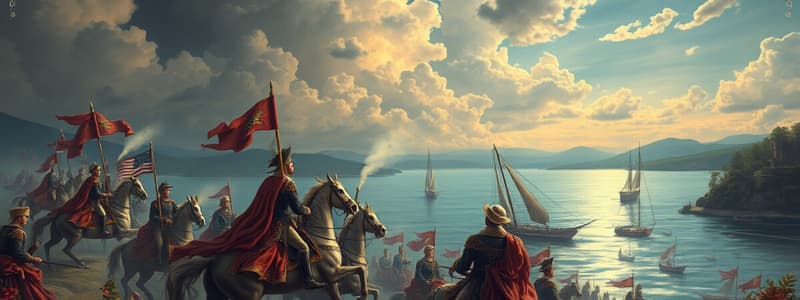Podcast
Questions and Answers
What was the outcome of the Battle of Lake Champlain?
What was the outcome of the Battle of Lake Champlain?
- The battle ended in a tie.
- There was heavy damage inflicted, but it reached a stalemate. (correct)
- The Americans easily defeated the British.
- The British achieved a decisive victory.
Who crushed the Red Sticks at Horseshoe Bend?
Who crushed the Red Sticks at Horseshoe Bend?
General Andrew Jackson
What event occurred two weeks after the war's official conclusion?
What event occurred two weeks after the war's official conclusion?
- The start of the War of 1812
- The defeat of General Andrew Jackson
- The signing of the Treaty of Ghent
- The Battle of New Orleans (correct)
What did the Treaty of Ghent restore?
What did the Treaty of Ghent restore?
Which program did President Madison recommend after the War of 1812?
Which program did President Madison recommend after the War of 1812?
Who was the president of the Second Bank of the U.S.?
Who was the president of the Second Bank of the U.S.?
The Tariff of 1816 was designed to aid industries that flourished during the War of 1812.
The Tariff of 1816 was designed to aid industries that flourished during the War of 1812.
When did construction of the National Road begin?
When did construction of the National Road begin?
What did the Erie Canal link?
What did the Erie Canal link?
Which invention is Robert Fulton known for?
Which invention is Robert Fulton known for?
Flashcards are hidden until you start studying
Study Notes
The Battle of Lake Champlain
- British forces faced heavy losses but failed to achieve military objectives, leading to a stalemate in the war.
General Andrew Jackson
- In 1813, the Red Sticks attacked Fort Mims, resulting in widespread casualties.
- In response, Jackson united militias and Native Americans against the Red Sticks, defeating them at Horseshoe Bend in March 1814.
- He became a major general and took control of Pensacola before advancing towards New Orleans.
- The Battle of New Orleans on January 8, 1815, saw Jackson's less-trained army defeat British forces, inflicting over 2,000 British casualties compared to only 21 American losses.
The Battle of New Orleans
- Occurred after the official end of the War of 1812; the Treaty of Ghent was signed December 24, 1814, but was unknown in America at the time.
- Jackson's victory raised his national profile and fostered a sense of pride among Americans.
The Treaty of Ghent
- Negotiated without Native American representatives, it essentially restored prewar conditions and ended hostilities.
- Key provisions included the release of prisoners and restoration of conquered territories, but failed to address impressment or maritime rights.
- British demands for territorial changes and Native American sovereignty went unfulfilled.
President Madison's Nationalist Program
- Post-war, Madison and the Democratic-Republicans adopted a nationalist agenda, incorporating ideas from federalists regarding government support for growth.
- Madison's December 1815 Congressional message emphasized economic development and military expansion.
- His agenda, known as the American System, called for a national bank, improved transport networks, and protective tariffs, while adhering to Jeffersonian principles regarding state authority over infrastructure.
The Second Bank of the U.S.
- Many states resented the national bank's influence, feeling it did not cater to local economies.
- Nicholas Biddle served as president, shaping the bank’s policies and direction.
The Tariff of 1816
- Aimed at protecting American industries, this tariff taxed imported goods like wool, cotton, iron, and sugar that were vulnerable to foreign competition.
- The tariff highlighted growing divisions within the nation rather than promoting unity.
The National Road
- Authorized by Congress in 1806, construction on the Cumberland Road (National Road) started in 1811 and was completed in 1818.
- The road connected Cumberland, Maryland, to Wheeling, Virginia, and was later extended towards Columbus, Ohio, promoting westward expansion.
The Erie Canal
- Built from 1817 to 1825, this canal linked the Great Lakes to the Atlantic, funded largely by the State of New York after federal funding was vetoed.
- It significantly enhanced trade and settlement in the upper Midwest.
Robert Fulton
- Renowned for developing the first practical steamboat; Fulton's Clermont made successful trips on the Hudson River in 1807, revolutionizing transportation.
Studying That Suits You
Use AI to generate personalized quizzes and flashcards to suit your learning preferences.




